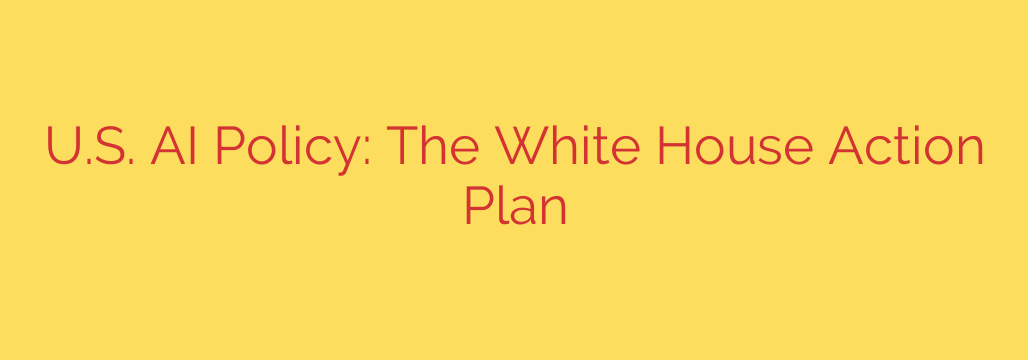
The White House Unveils Landmark AI Policy: What You Need to Know
Artificial intelligence is rapidly reshaping our world, moving from a futuristic concept to a daily reality. Recognizing the immense potential and significant risks of this technology, the U.S. government has rolled out a comprehensive national strategy. This new framework aims to steer the development and deployment of AI, ensuring it serves the public good while mitigating potential harm.
This is not just another policy paper; it’s a foundational plan designed to manage one of the most powerful technologies of our time. For businesses, developers, and the public, understanding this strategy is crucial. Here’s a breakdown of the key pillars of the U.S. approach to artificial intelligence.
Establishing New Standards for AI Safety and Security
The primary concern addressed by the new policy is the safety and security of advanced AI systems. As these models become more powerful, their potential for misuse—whether intentional or accidental—grows. The government is taking a direct role in establishing safeguards.
The most significant measure is the requirement for accountability. Developers of the most powerful AI systems will now be required to share their safety test results and other critical information with the U.S. government. Before these models are released to the public, they must undergo rigorous “red-teaming,” where experts actively try to find flaws and vulnerabilities.
This initiative is designed to:
- Protect against national security threats, such as AI’s potential use in designing dangerous biological materials or in cybersecurity attacks.
- Create standardized testing protocols through institutions like the National Institute of Standards and Technology (NIST) to ensure all high-impact AI systems meet a consistent safety bar.
- Develop systems to detect AI-generated content and authenticate official content, a crucial step in combating deepfakes and misinformation.
Championing American Innovation and Competition
While safety is paramount, the government’s strategy is equally focused on ensuring the United States remains a global leader in AI innovation. The goal is to create an environment where progress can flourish without being monopolized by a few dominant players.
Key actions in this area include promoting a vibrant and competitive AI marketplace. The plan aims to foster a competitive AI ecosystem, preventing monopolies and supporting small developers, startups, and researchers. By providing access to technical assistance and federal resources, the government seeks to level the playing field.
Furthermore, the policy addresses the global competition for talent. It outlines plans to streamline visa processes for top AI researchers and experts from around the world, making it easier for them to study, work, and innovate within the United States.
Protecting Privacy and Upholding Civil Rights
One of the most pressing public concerns about AI is its potential to erode privacy and perpetuate societal biases. AI systems are trained on vast amounts of data, and if that data is flawed or biased, the AI’s decisions will be as well.
The new policy places a strong emphasis on fairness and transparency. A central goal is to prevent AI algorithms from perpetuating bias and discrimination, particularly in critical areas like housing, employment, and the criminal justice system. The government will provide clear guidance and best practices for developers and organizations using AI to ensure their systems are equitable and rights-preserving. This includes prioritizing the protection of personal data used in AI development and deployment, giving Americans more control over their information.
Supporting Workers and Consumers
The rise of AI will inevitably transform the labor market and the consumer landscape. The government’s plan acknowledges these shifts and includes measures to support American workers and protect consumers.
The strategy calls for studies on AI’s labor-market impact and the development of principles to support workers during this technological transition. This involves investing in workforce training programs, protecting labor rights, and ensuring that the benefits of AI are shared broadly, not just concentrated at the top.
For consumers, the focus is on transparency and protection from AI-enabled fraud or harm. You have a right to know when you are interacting with an AI system, and this policy aims to make those interactions clearer and safer.
Actionable Steps for Your Organization
This national AI strategy is a call to action. For businesses and other organizations, now is the time to prepare for a more regulated and transparent AI landscape.
- Conduct an AI Audit: Understand where and how your organization is using AI. Document the models, the data they use, and the decisions they influence. This is the first step toward responsible governance.
- Prioritize Data Privacy and Security: Review your data handling practices to ensure they align with emerging privacy principles. Secure, high-quality, and unbiased data is the bedrock of safe AI.
- Invest in Responsible AI Training: Your teams—from developers to managers—need to understand the ethical implications of AI. Training on identifying bias, ensuring transparency, and maintaining accountability is no longer optional.
- Stay Informed on Evolving Standards: This policy is the beginning, not the end. Follow updates from NIST and other federal agencies to ensure your AI governance framework remains compliant and effective.
The Path Forward: Balancing Progress with Precaution
The U.S. AI strategy represents a monumental effort to get ahead of a transformative technology. It seeks a delicate balance: fostering rapid innovation while building strong guardrails to protect the public. This is not about stifling progress but about guiding it in a responsible direction.
The goal is clear: to steer the development of AI toward a future that is not only innovative but also safe, equitable, and aligned with core democratic values.
Source: https://blog.cloudflare.com/the-white-house-ai-action-plan-a-new-chapter-in-u-s-ai-policy/








